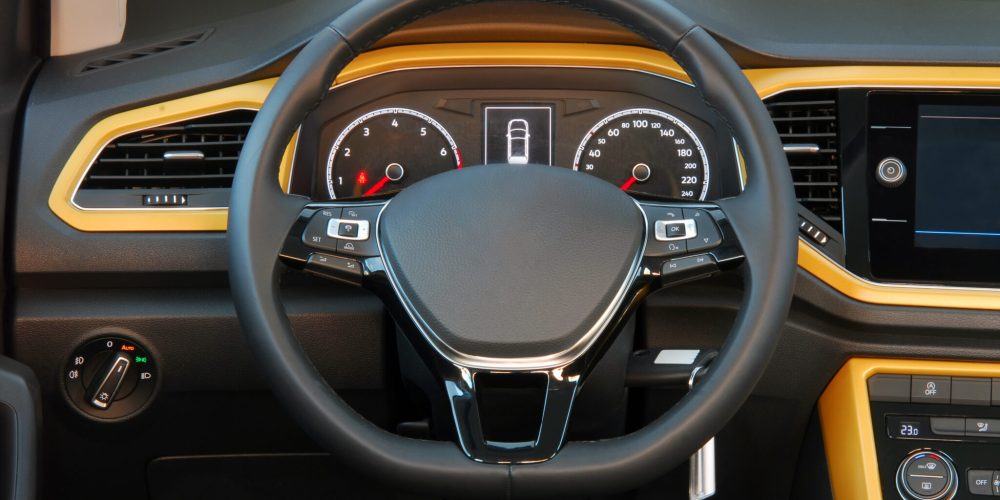Have you ever wondered how your car is able to accurately respond to the turns of the steering wheel? One key player in this process is the steering angle sensor. The steering angle sensor is a small but crucial device that measures the angle of the steering wheel and sends this information to the vehicle’s electronic control unit (ECU). Steering angle sensors play a large role in vehicle safety and ADAS (Advanced Driver Assistance Systems), ensuring that your vehicle reacts precisely to your steering inputs. In this article, we’ll explain what steering angle sensors are, how they work, and why these sensors are so important for modern vehicles.
What is a Steering Angle Sensor?
In simple terms, a steering angle sensor is like a communication link between your steering wheel and your car’s computer system. Imagine when you turn your car’s steering wheel; you’re telling the car where you want to go. The steering angle sensor listens to this ‘message’ – it keeps track of how much, how fast, and in what direction you’re turning the wheel. It then sends this information to the car’s computer, which uses it to control the wheels to match the inputs. This allows for precise control of the vehicle’s steering.
There are two main types of steering angle sensors: analog and digital sensors. Analog steering angle sensors usually use a potentiometer setup. This setup has a resistive track and a wiper that moves along it as the steering wheel turns, changing the resistance and the output voltage accordingly. This analog voltage signal is proportional to the steering wheel’s position, providing a simple yet effective way to measure steering input.
On the other hand, you have digital steering angle sensors. These sensors often using LED technology, and can provide more accurate and reliable readings. These digital steering angle sensors use optical encoding to measure the angle of the steering wheel, with a light source and photodiode detecting the movement of a coded disc attached to the steering shaft. The precision and reliability of digital steering angle sensors make them ideal for modern vehicles, ensuring enhanced performance and safety.
The Role of Steering Angle Sensors in Vehicle Safety
Steering angle sensors are fundamental to modern vehicle safety. They are part of a network of sensors that help maintain vehicle stability and control. Here’s how they contribute to driver safety:
Electronic Stability Control (ESC): ESC systems use data from the steering angle sensor to detect when you lose control of your steering. They automatically apply brakes to help “steer” the vehicle in the direction you want to go. By keeping an eye on your steering angle and comparing it to the actual path, ESC can spot situations where your intended path doesn’t match the real one. This happens during sudden moves or on slippery surfaces. When this happens, ESC steps in by applying the brakes to specific wheels. This helps the vehicle regain stability and reduces the chances of skidding or spinning out of control.
Advanced Driver Assistance Systems (ADAS): Features like lane-keep assist and blind-spot monitoring rely on accurate steering angle data to work properly. With the help of the steering angle sensor, these ADAS technologies can monitor the driver’s intended steering inputs and compare them to the actual movement of the vehicle. For example, if the car starts drifting from its lane without using the turn signal, the lane-keeping assist system can use the steering angle data to figure out what needs to be done, gently nudging the car back into the right lane.
Also, if the sensor data indicates that the driver is steering toward a vehicle detected in the blind spot, the system will alert the driver. This can be achieved through visual cues, such as flashing lights in the side-view mirror or audible alerts. Some active ADAS systems will take control of the wheel in this situation, steering the car away from the potential collision.
Autonomous Driving: In the future, steering angle sensors will be important for the integration of autonomous driving. As self-driving cars try to navigate roads safely without human intervention, they depend on accurate and continuous steering angle data. By using the steering angle sensor’s info, self-driving cars can make sure they maneuver precisely, stay in the lane, and navigate reliably. This helps create a safer and more efficient transportation system.
Troubleshooting and Calibration of Steering Angle Sensors
The calibration of steering angle sensors is a vital step for the functioning of ADAS and ESC systems. Calibration adjusts the sensor to provide accurate measurements, considering real-world variables like road curvature, alignment issues, or tire wear. If the sensor is not calibrated properly, the ADAS might misinterpret steering inputs, leading to false warnings or inappropriate vehicle responses.
Signs of a Malfunctioning Steering Angle Sensor
A malfunctioning steering angle sensor can cause issues with the ESC system and ADAS. Signs of a malfunctioning sensor include:
- ESC Warning Light: The Electronic Stability Control (ESC) warning light on the dashboard is often the first sign of a malfunctioning steering angle sensor. This light comes on when the system detects an error between the driver’s steering input and the vehicle’s actual path.
- Inconsistent Steering Response: An inconsistent or unpredictable steering response is another indication of a faulty steering angle sensor. This is a common issue after a wheel alignment, characterized by the vehicle veering to one side or the steering feeling heavier or lighter than usual.
- Loss of Stability Control Features: A loss of stability control features can also mean you have a faulty steering angle sensor. Features such as traction control, electronic stability control, or active steering might stop functioning properly.
To ensure the safety of your vehicle, we recommend seeking professional assistance for the inspection and repair of the steering angle sensor whenever necessary. Ignoring a malfunctioning sensor can increase the chances of accidents.
Get Started with Your Own ADAS Sensor Calibration Center Today
The steering angle sensor in modern vehicles plays a large role that often goes overlooked. A functioning steering angle sensor not only enhances driving safety but also regulates key features of your vehicle, including stability control and lane departure warnings. The calibration of these sensors is extremely important to avoid small inconveniences and major safety issues. To learn more about starting your own ADAS calibration center, contact us today!







